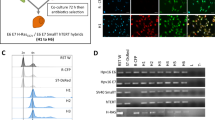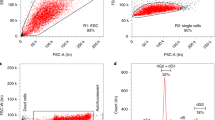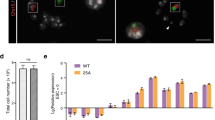Abstract
Staged reduction of the chromosome complement of human–mouse hybrid cells has made possible the identification of the chromosome bearing the human gene for thymidine kinase. Effects of human chromosomes on the growth rate of hybrid cells are examined and the possibility of making further chromosomal assignments for human autosomal genes is discussed.
This is a preview of subscription content, access via your institution
Access options
Subscribe to this journal
Receive 51 print issues and online access
$199.00 per year
only $3.90 per issue
Buy this article
- Purchase on Springer Link
- Instant access to full article PDF
Prices may be subject to local taxes which are calculated during checkout
Similar content being viewed by others
References
Weiss, M., and Green, H., Proc. US Nat. Acad. Sci., 58, 1104 (1967).
Kit, S., Dubbs, D. R., Piekarski, L. J., and Hsu, T. C., Exp. Cell Res., 31, 297 (1963).
Kit, S., Piekarski, L. J., and Dubbs, D. R., J. Mol. Biol., 6, 22 (1963).
Hayflick, L., and Moorhead, P. S., Exp. Cell Res., 25, 585 (1961).
Todaro, G. J., Wolman, S., and Green, H., J. Cell Comp. Physiol., 62, 257 (1963).
Weiss, M., Todaro, G. J., and Green, H., J. Cell Physiol., 71, 105 (1968).
Ephrussi, B., and Sorieul, S., University of Michigan Medical Bulletin, 28, 347 (1962).
Littlefield, J. W., Exp. Cell Res., 41, 190 (1966).
Ephrussi, B., Interspecific Somatic Hybrids in vitro, 2, 40 (Williams and Wilkins, 1966).
Weiss, M., and Ephrussi, B., Genetics, 54, 1095 (1966).
Yerganian, G., and Nell, M. B., Proc. US Nat. Acad. Sci., 55, 1066 (1966).
Harris, H., Watkins, J. F., Campbell, G. L. M., Evans, E. P., and Ford, C. E., Nature, 207, 606 (1965).
Weiss, M., Ephrussi, B., and Scaletta, L. J., Proc. US Nat. Acad. Sci., 59, 1132 (1968).
Gerald, P. S., Warner, S., Singer, J. D., Corcoran, P. A., and Umansky, I., J. Pediat., 70, 172 (1967).
Littlefield, J. W., Science, 145, 709 (1964).
Nyhan, W. L., Pesek, J., Sweetman, L., Carpenter, D. G., and Carter, C. H., Pediat. Res., 1, 5 (1967).
Seegmiller, J. E., Rosenbloom, F. M., and Kelley, W. N., Science, 155, 1682 (1967).
Ham, R. G., Exp. Cell Res., 29, 515 (1963).
Fischer, G. A., and Welch, A. D., Science, 126, 1018 (1957).
Author information
Authors and Affiliations
Rights and permissions
About this article
Cite this article
MATSUYA, Y., GREEN, H. & BASILICO, C. Properties and Uses of Human–Mouse Hybrid Cell Lines. Nature 220, 1199–1202 (1968). https://doi.org/10.1038/2201199a0
Received:
Revised:
Issue Date:
DOI: https://doi.org/10.1038/2201199a0
This article is cited by
-
A method to generate microcells from human lymphoblasts for use in microcell mediated chromosome transfer
In Vitro Cellular & Developmental Biology (1986)
-
Human chromosomes control growth of human-chinese hamster somatic cell hybrids
Somatic Cell Genetics (1982)
-
Selection of triparental somatic hybrids between mouse and Chinese hamster cell lines
Somatic Cell Genetics (1981)
-
Assignment of the structural genes for the ? subunit of hexosaminidase A, mannosephosphate isomerase, and pyruvate kinase to the region q22-qter of human chromosome 15
Somatic Cell Genetics (1977)
-
Confirmation of the human thymidine kinase locus, 17q21 ? 17qter, by means of a man-mouse somatic cell hybrid, D98/AH-2 X LMTK?Cl-1D
Human Genetics (1976)
Comments
By submitting a comment you agree to abide by our Terms and Community Guidelines. If you find something abusive or that does not comply with our terms or guidelines please flag it as inappropriate.



